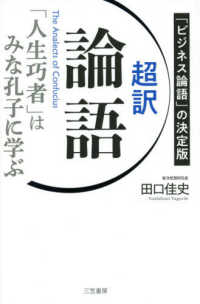- ホーム
- > 洋書
- > 英文書
- > History / World
Full Description
The book students will readThe West: A Narrative History is a concise but not abridged introduction to the West, encompassing all cultures that trace their ancestry to the ancient Mediterranean world. It is not a reduced version of a larger study, but a full narrative of the West written concisely. This learning program is built around a Key Question in every chapter, a feature that shows students why western civilization is relevant for them. Students will discover the key questions that define the past are in many ways the same key questions of today. Since students often see conflict between a Christian "West" and an Islamic "East" in today's society, the authors highlight the ongoing role the Middle East has played in shaping the West. Students will understand the links between people of the West and those in other regions. The West is an accessible program available in several formats to give instructors and students more choices and more ways to save. With the release of the 3rd edition, The West becomes an integrated program tied closely to the new MyHistoryLab. A better teaching and learning experienceThis program will provide a better teaching and learning experience-for you and your students. Here's how:Personalize Learning - The new MyHistoryLab delivers proven results in helping students succeed, provides engaging experiences that personalize learning, and comes from a trusted partner with educational expertise and a deep commitment to helping students and instructors achieve their goals. Improve Critical Thinking - Each chapter opens with a Key Question and a brief Key Question essay. The Key Question is revisited at the end of the chapter, and MyHistoryLab Icons and Connections features ensure close integration with the new MyHistoryLab. Engage Students - Maps, illustrations, and a biography feature promote discussion of the narrative. Support Instructors - MyHistoryLab, Class Preparation Tool, Instructor's Manual, MyTest, Annotated Instructor's eText, and PowerPoints are available to be packaged with this text. Note: MyHistoryLab does not come automatically packaged with this text.
Contents
Found in this section:1. Brief Table of Contents2. Full Table of ContentsIntroductionPart I Departure Prehistory to 1000 B.C.E.Chapter 1 The Birth of Civilization Chapter 2 The Rise of Empires and the Beginning of the Iron AgePart II The Classical Era 2000 B.C.E. to 30 C.E.Chapter 3 Aegean CivilizationsChapter 4 The Hellenic Era Chapter 5 The Hellenistic Era and the Rise of RomeChapter 6 Rome's Empire and the Unification of the Western WorldPart III The Division of the West 300 to 1300Chapter 7 The West's Medieval CivilizationsChapter 8 The Emergence of Europe Chapter 9 Europe Turns OutwardChapter 10 Europe's High Middle AgesPart IV Challenges, Conflicts, and Departures 1300 to 1700Chapter 11 Challenges to the Medieval OrderChapter 12 Renaissance and ExplorationChapter 13 Reformation, Religious Wars, and National Conflicts Part V The Revolutionary ImpulseChapter 14 The Early Modern StateChapter 15 New World Views: Europe's Scientific RevolutionChapter 16 The Age of Enlightenment: Rationalism and its UsesChapter 17 Rebellion and Revolution: American Independence and the French Revolution Part VI Europe Triumphant 1815 to 1914Chapter 18 Industry, Society, and EnvironmentChapter 19 The Age of Ideology in Western EuropeChapter 20 The Consolidation of Nation StatesChapter 21 Global Empire and European CulturePart VII Europe in Crisis 1914 to 1945Chapter 22 World War I: The End of EnlightenmentChapter 23 The Troubled Interwar YearsChapter 24 World War II: Europe in EclipsePart VIII The Postwar Western Community 1945 to 2008Chapter 25 Decolonization and the Cold WarChapter 26 Western Civilization and the Global CommunityIntroductionPart I - Departure Prehistory to 1000 B.C.E.Chapter 1: The Birth of CivilizationKey Question: How do environments shape human communities and human communities alter environments?The Evolution of the Prehistoric Cultures The Archaic States The Origin of Civilization in Mesopotamia: Sumer The Rise of Civilization in EgyptChapter 2: The Rise of Empires and the Beginning of the Iron AgeKey Question: Does civilization promote or intensify divisions among peoples?The Transition StatesImperial Egypt: The New Kingdom The Indo-Europeans and the Clash of EmpiresThe Bible and HistoryPart II - The Classical Era 2000 B.C.E. to 30 C.E.Chapter 3: Aegean CivilizationsKey Question: When does civilization in the West become "Western" civilization?Minoan MentorsThe Mycenaeans, Greece's First Civilization The Aegean Dark AgeThe Hellenic EraThe Rise of the Mainland Powers The Persian Wars: Crucible of a CivilizationChapter 4: The Hellenic EraKey Question: What did the Greeks contribute to the development of modern civilization?Persian Wars as Catalyst The Peloponnesian War Intellectual and Artistic Life in the PolisChapter 5: The Hellenistic Era and the Rise of RomeKey Question: What circumstances are likely to undermine governments by the people?The Hellenistic EraThe Origin of RomeThe Roman RepublicRome's Civil WarChapter 6: Rome's Empire and the Unification of the Western World Key Question: Do people prefer order to liberty?The Augustan Era Order and Continuity: The Dynastic Option Order and Continuity: The Elective Option Life in an Imperial Environment The Decline of RomePart III - The Division of the West 300 to 1300Chapter 7: The West's Medieval CivilizationsKey Question: Should freedom of religion be limited?The Christian Element The German Element The Byzantine Empire of Constantinople IslamChapter 8: The Emergence of Europe Key Question: How did Europe build on its legacies from the ancient world?The Merovingian Kingdom: Europe's NucleusThe Franks' Neighbors The Carolingian Era Retrenchment and Reorganization The Culture of Europe's Dark Age Chapter 9: Europe Turns OutwardKey Question: Was conflict among the medieval civilizations inevitable?Islam's Crest and Byzantium's ResurgenceThe Reorganization of Feudal EuropeThe Eleventh-Century Turning PointChapter 10: Europe's High Middle AgesKey Question: Why are some societies more open to change than others?The Renaissance of the Twelfth CenturyUniversities and Scholasticism Religious Revival and Diversity of Opinion The Artistic Vision of the High Middle Ages Government in the High Middle AgesPart IV - Challenges, Conflicts, and Departures 1300 to 1700Chapter 11: Challenges to the Medieval Order Key Question: What did the crises of the late medieval era reveal about the strengths and weaknesses of Europe's civilization?Challenges from Nature Turmoil in the Middle East Spiritual Crises Political Responses: The Burdens of WarChapter 12: Renaissance and ExplorationKey Question: How should a society use its history?The Context for the Renaissance The Culture of the Renaissance The Northern Renaissance The Middle East: The Ottoman Empire Europe and Atlantic ExplorationChapter 13: Reformation, Religious Wars, and National ConflictsKey Question: How do civilized societies justify war?The Lutheran ReformationThe Swiss Reformation The Catholic Reformation The Habsburg-Valois Wars England's Ambivalent Reformation Convergence of Foreign and Domestic Politics: England, Spain, and France The Final Religious Upheaval Part V The Revolutionary ImpulseChapter 14: The Early Modern StateKey Question: How do political systems reflect the structure of social and economic life?Society in Early Modern EuropeForging Centralized StatesAbsolutism in FranceConstitutionalism in EnglandWars of Empire and Global MarketsCentral and Eastern EuropeEurope's Declining PowersChapter 15: New World Views: Europe's Scientific RevolutionKey Question: How does the study of the natural world influence religious belief and the understanding of truth?The Medieval World ViewAnticipating the New ScienceNew Directions in Astronomy and PhysicsNew Approaches to TruthTheory and ApplicationPolitics as ScienceScience as ReligionSuperstition and Its VictimsChapter 16: The Age of Enlightenment: Rationalism and its UsesKey Question: How do people construct ideas of progress?Critiquing the Traditional Way of LifeFormulas for Improving Material ConditionsEnlightened DespotsCritiquing the EnlightenmentThe Arts in the Age of ReasonChapter 17: Rebellion and Revolution: American Independence and the French RevolutionKey Question: Can political change occur without social and economic upheaval?America Rejects EuropeRevolution in FranceNapoleon Bonaparte and the Export of Revolution, 1799-1815The French Revolution and the AmericasPart VI Europe Triumphant 1815 to 1914Chapter 18: Industry, Society, and EnvironmentKey Question: How do technology and urbanization influences the relationship between humans and nature?From Rural to Urban Lifestyles in EuropeAgriculture, Demographics, and LaborInnovations in ProductionThe Social Consequences of IndustrializationIndustry, the State, and Global Power Chapter 19: The Age of Ideology in Western EuropeKey Question: What leads people to challenge conventional ideas and practices?The Congress System and the Conservative AgendaIdeological FermentThe Revolutions of 1848 Britain and ReformThe Romantic MovementUtilitarianism and Utopian SocialismThe Marxist Challenge Chapter 20: The Consolidation of Nation StatesKey Question: Is nationalism a constructive force in the modern age?Italian UnificationThe Creation of Modern GermanyConstitutional Change in France and BritainThe Waning of the Habsburg, Russian, and Ottoman EmpiresThe United States and Western EuropeNationalism and RaceChapter 21: Global Empire and European CultureKey Question: How does the projection of power reflect wider cultural values?The New Imperialism: Motives and MethodsThe Scramble for Empire: AfricaThe Scramble for Empire: South and East AsiaThe Legacy of EmpireImperialism, Intellectual Controversy, and European CultureTransformation in the ArtsPart VII Europe in Crisis 1914 to 1945Chapter 22: World War I: The End of EnlightenmentKey Question: Are nation states inherently adversarial?The Alliance SystemThe Experience of Modern WarfareThe Eastern Front and Europe's EmpireNaval War and American EntryThe Impact of Total War at HomeBolshevik Revolution in RussiaPeace Settlement and European Consciousness Chapter 23: The Troubled Interwar YearsKey Question: Can personal liberty be maintained under conditions of material hardship?Postwar Problems in Western EuropeThe Price of VictoryThe Great Depression, 1929-1939Coping with the DepressionItaly: The First Fascist StateAuthoritarian Regimes in Spain and Eastern EuropeThe Emergence of Nazi GermanyImperial JapanThe Soviet Union under StalinChapter 24: World War II: Europe in EclipseKey Question: Can the force of ideas sustain a civilization under attack?The Process of Appeasement, 1933-1939Nazism Triumphant, 1939-1941: Europe and North AfricaThe German EmpireThe Destruction of the JewsThe Home Front and the Role of WomenWar in Asia and the PacificThe Tide Turns, 1942-1945Planning for the Postwar WorldPart VIII The Postwar Western Community 1945 to 2008Chapter 25: Decolonization and the Cold WarKey Question: How does ideology shape public policy?The Eclipse of Postwar OptimismThe End of European EmpireExpanding the Cold WarThe Cold War and Nuclear ThreatCuban Missile CrisisDivisions and DetenteChapter 26: Western Civilization and the Global CommunityKey Question: Has the West defined the process of globalization?The End of CommunismUnited Europe?Science, Technology and the EnvirnomentWomen and the Struggle for EqualityReligious Divides and Ethnic NationalismThe Postindustrial West







